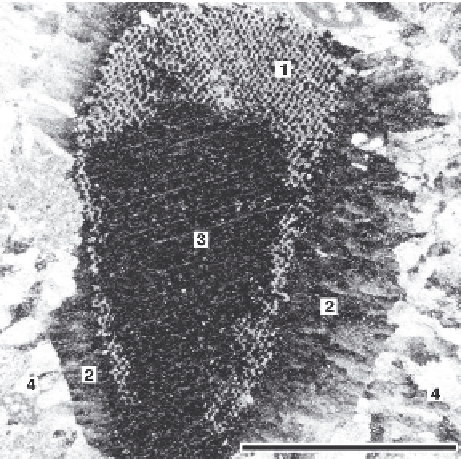Geology Reference
In-Depth Information
• Syntaxial overgrowth as a filling of secondary pore
space created by the selective dissolution of micrite
matrix in the vicinity of echinoderm grains (solution
corona model: Walkden and Berry 1984). The model
involves mechanisms of early near-surface meteoric dis-
solution of the micritic matrix accompanied by prefer-
entially downward enlarged overgrowth on the surface
of the echinoderm grains.
• Neomorphic replacement of micrite operating across
a thin solution film (Bathurst 1958; Orme and Brown
1963). This model has been used in many studies.
• Syntaxial overgrowth into primary sheltered voids
beneath echinoderm fragments (Görur 1979). The se-
lective displacement of micrite beneath the skeletal
grains may be facilitated by the high permeability of
the pores of the echinoderm stereome acting as path-
ways for undersaturated vadose water that precipitates
gravitative cements.
Fig. 7.10.
Echinoderm overgrowth rim cement.
Syntaxial
overgrowth on an echinoid fragment exhibiting relicts of the
original net-like microstructure (1). The overgrowth ce-
ment (2) occurs in optical continuity with the monocrystalline
host grain (3), as indicated by the corresponding orientation
of the faint cleavage planes. The skeletal grain acted as a
substrate for radiaxial cements whose crystals are cut in
various directions (4). Crossed nicols. Upper part of a
carbonate ramp. Late Triassic: Steinplatte, Tyrol, Austria.
Scale is 1 mm.
Most authors interpret the syntaxial overgrowth ce-
ments to be of meteoric diagenetic origin (e.g. Longman
1980; Kaufman et al. 1988). However, overgrowth ce-
ments on echinoderms are also common in ancient lime-
stones formed in marine environments (Walker et al.
1990). These thin cloudy overgrowth cements often rep-
resent the first generation of overgrowth on echinoderm
grains followed by a continued growth under meteoric
conditions.
a diverging pattern of optical axes coinciding with that
of subcrystals.
• Radial-fibrous calcite consisting of turbid crystals
without undulose extinction (Davies 1977; Mazzullo
1980).
Megacements:
Cements consisting of conspicuously
large, millimeter- to centimeter-sized calcite crystals
have been reported from different environments:
• Large seafloor calcite cements were recorded from
the Proterozoic and interpreted by strong oversaturation
of the seawater (Grotzinger 1994; Sami and James
1994) and from Lower Triassic shelf sediments believed
to have been deposited in oxygen-restricted settings sub-
sequent to the Permian-Triassic catastrophic event
(Woods et al. 1999).
• Another example of megacements are crusts of pali-
sade cements consisting of large, up to 10 cm long,
black calcite crystals occurring in sheet cracks, cavi-
ties, and neptunian dikes of basinal limestones, and as
reworked constituents of debris flows (Wendt and Belka
1991). These cements contain ghost structures of former
marine fibrous aragonite cements that were neomor-
phically replaced by calcite megacements, and later
corroded, broken and deposited in debris flows.
• Similar megacements are represented by
raggioni
cements
(Assereto and Folk 1980; Davies and Nas-
sichuk 1990; Iannace 1991, 1993) characterized by gi-
ant rays growing in crusts and lining the walls of
centimeter- to decimeter-sized cavities within tepee
Syntaxial calcite overgrowth cement:
Overgrowth
of clear rim cements in optical continuity with large
monocrystalline host grains (e.g. crinoid ossicles, echi-
noid plates; Fig. 7.10; Pl. 33/7) is a common texture in
wackestones, packstones and grainstones. These ce-
ments are easy to recognize, because echinoderm grains
are inclusion-rich and differ in color from clear inclu-
sion-poor cement (Pl. 34/3, Pl. 95/6). The origin of ce-
ment overgrowth on echinoderm fragments is explained
by
• syntaxial overgrowth before the deposition of ma-
rine muds (Evamy and Shearman 1965, 1969). The au-
thors showed by staining that each individual bar of
the echinoderm stereome generated its own microcrys-
tal. Contact of the microcrystals during subsequent
growth causes identical orientation and integration,
producing the characteristic single crystal cements of
many echinoderm grainstones. Departures from this
model were described by Braithwaite and Heath (1987).

